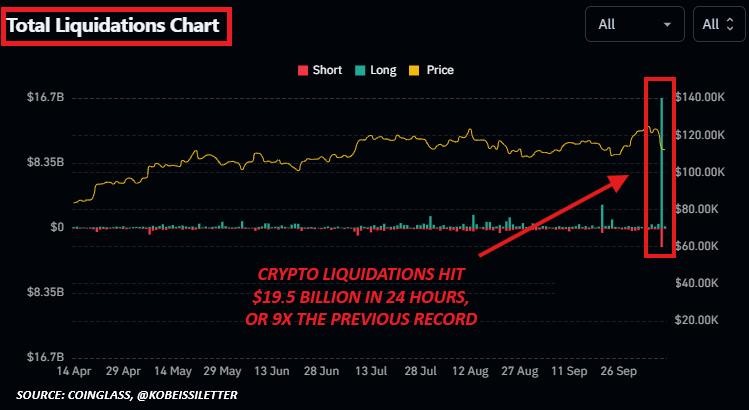The historic crash known as Crypto Black Friday wiped out more than $19.5 billion in leveraged positions in just a few hours, raising serious questions about what happened behind the scenes.
Initially XEM as a market panic due to news of US tariffs, many analysts now suspect that this was not just a sell-off but a sophisticated and organized market manipulation.
Unusual patterns and growing suspicions of market manipulation
The massive sell-off that rocked the crypto market on October 10–11, 2025, dubbed Crypto Black Friday by the community, became one of the most dramatic events in the history of the industry. In just a few hours, the market liquidated $19.5 billion in leveraged positions, causing Bitcoin (BTC) to fall 8.4% . CoinGlass suffered a sophisticated proxy attack, temporarily disrupting access to its website and services.
 Crypto liquidations occur when there is a rapid crash. Source: The Kobeissi Letter
Crypto liquidations occur when there is a rapid crash. Source: The Kobeissi LetterInitially, people attributed the crash to President Trump's announcement of 100% tariffs on Chinese goods. Analyst Phyrex explained that inflation fears and changes in Federal Reserve policy led to rapid liquidations in BTC, ETH, WBETH, and BNSOL. Low liquidation and Binance's temporary issues with frozen accounts exacerbated these problems. High leverage loans and the expansion of the USDE peg added to the crash. This prompted Binance to compensate users affected by the system issues.
However, many experts believe that this is not a simple chain reaction of panic selling. Analyst YQ questioned whether the crash was an organized market attack. Kook Capital also noted that Binance tried to beat Hyperliquid (HYPE) but failed.
“I believe Binance carried out this attack on its own to cause a massive liquidation across the industry,” Kook stated .
According to YQ's analysis, large trades were made before the Oracle update . This caused temporary mispricing and triggered cross-liquidation across assets. Some stablecoins lost their pegs within minutes, creating profit opportunities for arbitrage bots and potential bad actors.
“Is it a coincidence that out of thousands of trading pairs, only those with update announcements experienced such extreme peg losses? The possibility of this seems very small,” YQ commented .
YQ points to suspicious profit patterns related to the flow of money, including large short profits and large accumulations at the Dip of the price. These patterns are also related to unprecedented price disparities on exchanges. “These are not normal trading profits—they are profits at a predatory level,” YQ says.
Compared to previous market crashes, YQ assessed that if this was an organized attack, it would represent a new step in manipulating the cryptocurrency market.
“Instead of hacking the system or stealing keys, attackers will use the market structure itself as a weapon,” YQ commented.
However, some analysts believe that excessive leverage and thin liquidation are the main causes. When geopolitical concerns hit a market overloaded with perpetual Futures Contract , a cascade of liquidations can occur naturally. However, the timing and synchronization of the liquidations across platforms still keeps the “organized attack” theory alive.
Consequences and lessons for digital financial infrastructure
Crypto Black Friday has shaken investor confidence in the sustainability of major exchanges. While some platforms, including Binance, have pledged to provide compensation and audit systems, experts warn that this is only a temporary solution unless deeper issues — such as leverage mechanisms, oracle governance, and liquidation transparency — are addressed.
From a crypto infrastructure perspective, this event is a wake-up call for the entire Web3 ecosystem. The industry is building a multi-trillion dollar market on systems that are still very fragile. To prevent future “Black Fridays,” the community needs to increase on chain oversight, tighten risk management processes, and promote cooperation between exchanges, developers, and regulators.








